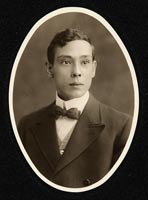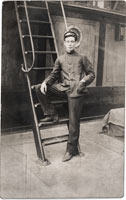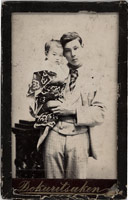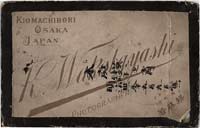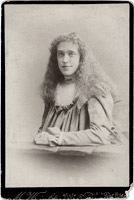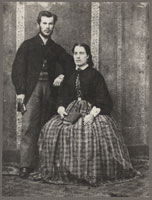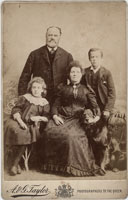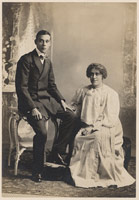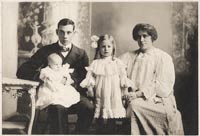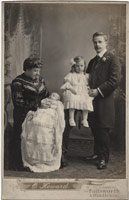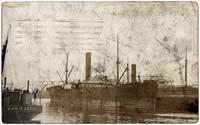WYKEHAM HENRY KOBA FREAME, DCMan ANZAC in the family
Having come to something of a brick wall on one of my own family history lines I turned my attention to my husband's. It being 2014 and the centenary of the start of the Great War I started to look at a family name I knew had military connections ... after all, we had the bullet that delivered the wound, engraved 'Dardanelles 1915'. This soldier had been a favourite uncle of my husband's own aunt, when she was a young girl. We had photos, a few letters and oral memories to start with but in many ways he was a man of mystery, with half Japanese / half Australian parentage. The fact that he made Australia his home around 1912/14 and returned there after he was discharged from the army meant that it wasn't going to be the easiest task. The first job was to try and verify the facts as we knew them but of which we didn't necessarily have documentary evidence. To get started I typed his name, Wykeham Henry Koba Freame into Google. What appeared on the screen wasn't quite what I expected! The first thing I saw was a copy of a photograph that was in our own family album! He was in the Australian Dictionary of Biographies! He was the subject of several newspaper and journal articles! He was written about, in glowing terms, in published military histories! He was reported as having served as a mercenary soldier in both Mexico and Africa! With a name like his, there could be no mistake about identity! It was obviously time to start separating fact from fiction. And so began a fascinating journey of discovery that I only wish my husband's aunt, Flossie, could have lived to enjoy. She adored this exotic uncle who appeared on fleeting visits when she was a child and sent postcards, just for her, enclosed in the letters to her parents. Before I even start the story I have to acknowledge that I owe my grateful thanks to the Armidale Historical Society, in NSW, for allowing me to see copies of two rigorously researched articles that were published in its journal. The earlier article was based on the documentation in the possession of Wykeham Henry's daughter, Josephine Grace Freame, and her own recollections. These were my starting point for the wider story surrounding 'Uncle Henry'. Lancashire, England, is geographically far distant from NSW and, regarding the details of Henry's life in Kentucky, his probable involvement in espionage and the subsequent controversy surrounding his death, I have relied heavily on 'the Gallipoli Samurai' by Brian Tait [10]. The author of this book includes in his sources, official records in the Australian Archives and some personal interviews. I purchased a copy from an Australian bookseller when I found references to it in other places. The author, an ex-policeman, brings investigative skills to his search and includes contextual history and information in an attempt to place Henry's story into its historical setting. Two of the earliest mysteries, created by Henry himself, were those of his age and birthplace. Henry was born on the 28th February but, over the passage of time, he gave 4 different birth years. Not actually an unusual occurence in those times! His birth year must have been 1880 as stated on his marriage certificate because his father is recorded as having died in December 1880[13]. When he enlisted in 1914 he gave his age as 29, shaving 5 years off his age, presumably to ensure that the army accepted him. His own son's birth certificate, in 1921, records him as 37 years old, giving him a birthdate of 1884 and, finally, in 1940, when he was issued with an army/diplomatic passport he gave his birth year as 1888. Similarly 'creative' with his birthplace, he states, on both his marriage certificate and attestation papers, that he was born in the tiny settlement of Kitscoty, near Edmonton in Alberta, Canada. In actual fact he was born in Osaka, Japan. He could not claim to be properly either Japanese, English or Australian. Did this mean he was stateless? His answer to question 3, regardijng nationality, on the 1914 Attestation papers was "Yes," indicating he was a British subject (as a 'naturalised' British Subject. he would have been required to show his papers). Did he feel that Kitscoty was sufficiently remote and tiny enough to ensure that he never met another one-time resident? It seems unlikely that he kept this pretence up for too long as in 'The Story of ANZAC' by C.E.W. Bean published in 1921 [7], Osaka is referred to as his place of birth.
So, back to the beginning ... Aunty Flossie died in 1996, age 94, and had always been a great source of family stories. She often talked of 'Uncle Henry' and adored him. We knew the outline of his story but now we needed to know more. The following narrative is the result of these searches. WYKEHAM HENRY KOBA FREAME, DCM Wykeham Henry Koba Freame ('Henry' from now on) was born in 1880 in Osaka, Japan, of an Australian father (William Henry Freame) and a Japanese mother, Shizu Kitagawa whom he had married in April 1873. Henry's father, William Henry Freame, was baptised in Thatcham, Berkshire, England, in May 1841 and was the son of Henry George Freame and Amy Price. They had been married in March 1840 in London. In the 1841 census they are recorded as living in Thatcham. Henry George's occupation is difficult to read. On the 1851 census the family are living in Brecon, Wales, and Henry George is a solicitor's managing clerk. William Henry is now age 10 and there are 3 sisters, Anna Gertrude (age 5) Susannah Florence (age 4) and Amy Sophia (age 2). Their circumstances are comfortable enough for them to afford a house servant. The following year, in 1852, they emigrated to Australia and made their home in Melbourne. The young William Henry married Ellen Jane Coker in 1867, in Melbourne, but it didn't last! However, before he left both Ellen and Australia, a son was born to the couple, who would be named William Henry George Freame. In 1870 William Henry was managing a dairy in Yokohama. In the same year his father, Henry George aged 63, died in Australia. Within a couple of years, William Henry was taking advantage of the fact that Japan was seeking more commercial contacts with the outside world and knowledge of the English language was a desirable skill. Seeing this as an opportunity, he became a teacher of English.[10] By 1873 he had met Shizu Kitagawa, asked her to marry him and she had agreed. Marriage between a Japanese person and a foreigner had only just been made possible and official permission was required (which was documented, and described on-line HERE). Theirs was the first marriage of this type to be officially recognised. Her name is usually recorded as Shizu Kitagawa, daughter of Kitagawa Yasuaki, a Samurai. It was a respected family with Samurai traditions and ethos. William, however, was a christian and it was as such that the young Henry would be brought up. To marry William, Shizu had to renounce her own Japanese citizenship. At some time between 1873 and 1880 a daughter, named Grace, was born to the couple. She would grow up, marry in Japan and have a daughter of her own who would be called Cecelia. Wykeham Henry was born to William and Shizu on the 28th February 1880. In December of 1880, William Henry died in Nagasaki, aged just 39 [ref 13]. William Henry had not registered his marriage, officially ... possibly because he was already married, and had a wife and young son in Australia! Probably unbeknown to William, his Australian wife had already lodged divorce proceedings against him, in March 1870, with the Victoria Supreme Court [10 p. 4]. Another source states that he was divorced by Ellen in 1877 - was this the year in which the divorce was actually granted and became effective?. The omission in registering the marriage meant that Shizu was able to regain her Japanese citizenship after William Henry's death but Henry, as the son of a 'foreign' father could not claim Japanese citizenship. We can only imagine what life was like, for the christian children of this marriage, growing up within an extended Japanese family with the bushido ethos. Later descriptions of his reserved temperament, disregard for personal safety, sense of honour and duty etc., all serve as reminders of the formal and disciplined upbringing that he must have experienced. His life was inevitably complicated by his mixed race ancestral heritage and historic bigotry ... it's more than probable that he was never totally accepted in any company. Brian Tate, in his book [10 p.21], suggests that Henry added 'Koba' to his name as a result of being 'adopted' by Stephen Koba, a Japanese Christian who would later "... head the Church of the Saviour in Osaka ..." Apparently it was not uncommon practice in Japanese families, when there was no male heir to the family name, to 'adopt' a 'son' from a worthy family, to carry on the lineage. Because it was more to do with continuation of the lineal name, an adoption could even be of an adult. Tate goes on to maintain that this was the case for Henry's father-in-law, who was himself adopted by the head of the influential Kitagawa family. [p.12]. In Henry's case, bearing in mind that his Christian father was died in the first year of his life, perhaps his 'adoption' was more in line with what, in Christian Churches is referred to as a 'godfather' ... a man who would care for the child's well-being and ensure that he was brought up with the Christian ethos. Some articles mention, variously, that he probably served in the Japanese navy at some stage and that he came to England in 1896 as part of his education but, again, I have no personal confirmation of this nor of where this information came from. One of the earliest verifiable piece of information that I have seen for myself is that of his seaman's 'Continuous Certificate of Discharge' which was in the possession of his daughter Grace and made available to the author of the 1984 article in the Armidale Historical Society Journal, by J.S. Ryan[5] whom, I understand, is the son-in-law of Wykeham Henry's 2nd wife. There was some damage to the first page but the first voyage shows a sign-off date of January 1902, in Avonmouth (Bristol), at the end of a voyage that took in Genoa and the Black Sea. The start date of his next voyage is also lost, but he was signed off 4 months later in May 1902 in Hull, after a voyage including the River Plate. The start dates of his next 2 voyages are also lost but both of them were to the Baltic and Bay Ports and signed off in, respectively, Middlesborough and Newcastle, in July and October, 1902. From that date (26th January 1905), he appears to have been almost continuously at sea, on just 2 long, consecutive voyages taking in Natal, Bombay, China and the USA and ending by signing off in Rotterdam in July 1906. He was married to Edith May Soppitt later that month, 19th July 1906, at St. John's, in Middlesborough. Just 9 weeks later and he would be signing on again.
However, in the meantime, in those first few weeks the newly married couple found time to visit Edith May's older brother, Frank Arthur, in Failsworth, near Manchester. In truth, Edith May and Frank Arthur were half-siblings as they shared a mother (Emily) but had different fathers. Their mother had been widowed at a young age, and then re-married. Frank Arthur Goodyear had been determined on a life on board ships for himself but his mother, knowing the perils of the sea, had tried to convince him otherwise. However, he couldn't be dissuaded and, as a teenager, signed on as a crewman. Even crossing the notorious Bay of Biscay didn't change his mind. Back on shore and it was decided, as a last desperate attempt to keep him away from the ships, to send him to relatives in Failsworth in order to get him away from the pull of the sea near his own home. It worked in that he found work, made friends and met the girl who would become his wife in 1900. Their first child, born in early 1902, was 'Flossie' (Florence May and named for Frank's sister, Edith May).
It was this little 'Flossie' who would become devoted to Uncle Henry after their visit in summer 1906, when she was just four and a half years old. In the years after that visit, Uncle Henry would write to the Goodyear family in England and include postcards for 'Flossie', which she treasured throughout her long life. Back to Henry, however, and his next voyage. He signed on in South Shields, on 1st September 1906, on the SS 'Aislaby' but his seaman's 'Continous Certificate ...' records that the voyage (destination not shown) was not completed and he did not sign off. This leaves a gap of 12 months on the certificate, until August 1907, when he signed on again in Middlesborough. We have no verifiable indication as to where he was or what he was doing in those months. However, it becomes very significant later in the story. In the years following the war some of Henry's exploits were being written about and probably gained an element of 'newspaper' glamour through some 'creative writing' and exaggeration. Some of the tales told about him included one that he had been a mercenary in Mexico during the Diaz regime; another that he had become a wanted man after a supposed coup in Mexico and yet another that he had served as a mercenary in Colonial German East Africa. The problems would arise when trying to fit all these adventures and exploits around the logged voyages he made as a crewman on board ship! In 1914, when Henry enlisted, one of the questions on the Attestation form asked about previous military experience and his answer was 'Mexican Army only'. Certainly, the skills that he showed as a scout, with the ANZACs, seem to indicate that he had had military experience somewhere. As a mercenary soldier we can imagine that the training might be 'on the job' and that you needed to learn quickly in order to survive. His reported exploits are not beyond the bounds of possibility ... The period of 12 months between 1906 and 1907 was probably the first of the only two opportunites in which he could realistically have been a mercenary soldier. He signed on in South Shields, on the 1st September, 1906, and his log shows that the journey wasn't completed and doesn't record the destination. However long he was away, and whatever it was that he was doing, he is next found signing on, in Middlesborough, in August 1907, for a 'foreign' voyage from which he was signed off in Antwerp in April 1908. The following day he signed on, on the same ship, going to China and Japan. It would be October 1908 before he was signing off again, after this voyage, in Middlesborough. He was in Middlesborough for 3 weeks then he was off again, in November, for a 13 week voyage to Brazil and back, signing off in February 1909.
In the next 12 months, between March 1910 and March 1911 he would sign on for voyages that included the River Plate (twice) and the West Indies (twice). During that time he was on shore for a total of only 5 weeks.
In the following 12 months there would be 3 voyages, to the River Plate (twice) and Australia once, with just 3 weeks between each of the voyages. The voyage to Australia seems to have been the first opportunity that Henry appears to have had to visit the country in which his father was born and where he had a half brother, aunts and other relatives still living. He signed off on the Australian voyage in February 1912, in London, and there is no record of his signing on again on another ship. Did he return to the North East and his wife? Did he fall in love with Australia on that voyage? Did he meet his father's other family there? Did he just feel it was time to make a life on dry land and returned to Australia? Whatever the answers, his precise whereabouts, between February 1912 and August 1914, are not known. This also provides the second period of time in which he could have been a mercenary soldier ... was he in Mexico and/or Africa during those months? Again ... it's not beyond the bounds of possibility. Whatever his reasons, and wherever he was, he returned to Australia at some time before August 1914, which is when he enlisted in the army, although his wife, Edith May, still remained in England. We can't know what Edith May, Henry's wife, felt about his long absences at sea, whilst she stayed on in the home of her parents. We can't know how she felt about the idea of uprooting herself from everything she knew and following her husband out to Australia, to a pioneering life. This was the husband of whom she had seen so little in the whole of the 8 years of their married life. Edith May's father had died in 1910 ... was the thought of leaving her widowed mother and brothers too great a wrench? We cannot know. What we do know, is that, in August 1914, when war broke out, Henry was in Glen Innes, New South Wales. employed breaking in horses (ref. his attestation papers [2]).
|
Sources: 1. Family letters, photos and documents. |
Page 1 |
